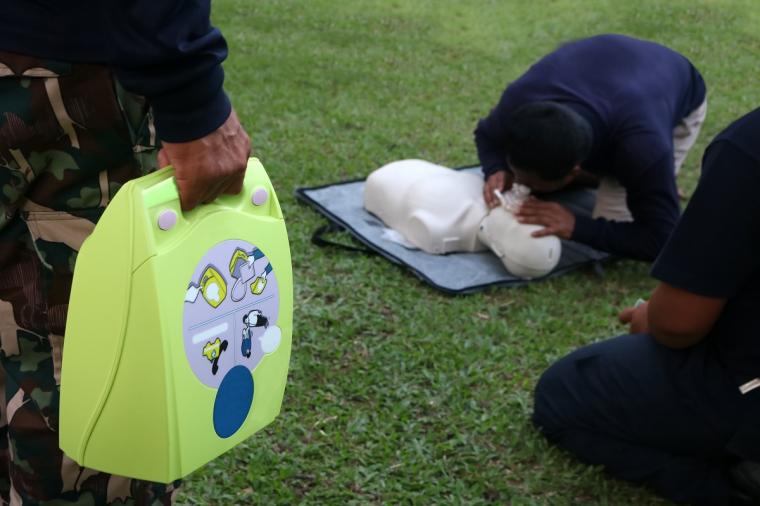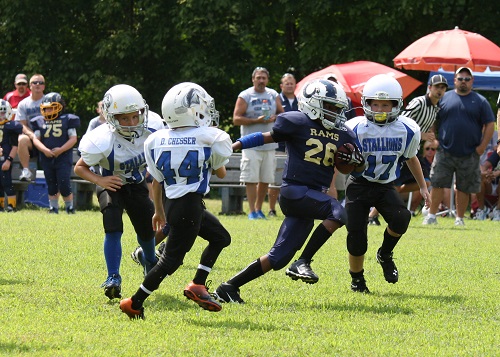
CPR saved Damar Hamlin’s life, and now the Buffalo Bills safety — who suffered cardiac arrest on the field during a Jan. 2 Monday Night Football game against the Cincinnati Bengals at Paycor Stadium — is paying it forward. Big time.
In early June, Hamlin kicked off his multi-city “Chasing M’s Foundation CPR Tour” in Buffalo on the Bills’ field at Highmark Stadium and distributed automated external defibrillators (AEDs) to about 50 youth sports organizations. (Hamlin created the foundation “as a vehicle to bring lasting impact to his community,” according to its GoFundMe page, which as of late June had raised more than $9.1 million.)
The Buffalo event also included free CPR training for more than 1,000 people, according to the Associated Press.
“Growing up playing sports, I never really remember ever thinking about where an AED was, or ever thinking about CPR training. I don’t ever remember a coach or a parent ever knowing where an AED was in a gym or stadium, or anywhere, for that matter,” Hamlin said during a brief speech at the event. “As we learned from my personal experience, it is very important and life changing. This program is very important because it gives life-saving care to kids in their own communities and on the field.”
The event was sponsored by the Bills, and the team also has partnered with the American Heart Association to provide other CPR training events in the region. Subequent CPR Tour stops were planned for Cincinnati, Pittsburgh and New York City.
“This is his legacy now,” Jordon Rooney, Hamlin’s marketing representative, told the AP. “It helped save his life and he wants to help save as many other lives as possible. It’s not just about awareness. It’s rebranding the messaging so that everyone learns CPR, and everyone knows how to use an AED.”
 Two of the Bills’ athletic trainers who helped save Hamlin’s life that night more than six months ago also are intent on helping save as many more lives as possible.
Two of the Bills’ athletic trainers who helped save Hamlin’s life that night more than six months ago also are intent on helping save as many more lives as possible.
Nate Breske and Denny Kellington spoke in June at the National Athletic Trainers’ Association Clinical Symposia and AT Expo in Indianapolis about the critical role pre-planning and regular practices played in helping them prepare for the worst-case scenario. And, as the AP notes, they’re urging school athletics personnel and youth sports leagues to develop their own emergency-action plans.
“First up, I don’t think anything can prepare you for what we went through in that moment,” Breske told the audience of athletic trainers from all levels of sport. “It was the first time we had seen it on a live human, but we had practiced it. We had done chest compressions before, we had done things with our paramedics and the other physicians, so we were ready, and everyone knew their role and what needed to happen in that moment.”
According to the NATA, only about one-third of all schools in the United States have access to a full-time athletic trainer despite, according to the AP, “statistics showing 93.4% of sports-related deaths in children are caused by sudden cardiac arrest, exertional heat stroke or exertional sickling, which can occur in people who carry the sickle cell trait.”
“There needs to be trainers out there,” Kellington said during the NATA conference’s panel discussion. “I know cost is one thing and communities don’t have the money to do it, but what’s the cost of a life? How can you not have somebody there? If that’s your child and something happens and there’s nobody there to help, how upset would you be just for lack of funding or lack of knowledge?”
He stressed individuals do not need to be certified in CPR or have used an AED in the past.
“Bystander CPR is a great way to save somebody’s life,” Kellington said. “The machine tells you what to do. The lack of not doing something is what puts kids in jeopardy. I think we all should take a look around and see what we’re all doing.”
In March, U.S. Sen. Corey Booker (D-N.J.) sponsored the bicameral, bipartisan Access to AEDs Act, which “directs the Secretary of Health and Human Services to award grants to elementary and secondary schools partnered with a nonprofit health care organization to develop and implement a comprehensive program to promote defibrillation access,” according to an announcement from Booker’s office.
The grants can be used to:
• Purchase AEDs and their necessary batteries and maintenance
• Replace old and outdated CPR and AED equipment, machinery and educational materials
• Provide CPR and AED training to students, staff and related sports volunteers
• Develop a Cardiac Emergency Response Plan
• Assist schools’ athletic departments in developing heart screening programs for student-athletes
• Establish a clearinghouse database for the reporting of AED devices already in schools
• Establish a clearinghouse database to gather information on sudden cardiac arrest in the pediatric population for further research
Currently, only 23 states have AED school requirements, with varying degrees of specificity regarding mandates on whether schools must have AEDs on campus and provide the necessary training on their use, according to Booker.
“Student-athletes are more than 3.5 times likely to experience sudden cardiac arrest than non-athletes,” he said in a statement. “[It is] often fatal if appropriate steps are not taken quickly. We can increase the survival rate from cardiac arrests if more schools, where our children learn and play, have access to AEDs.”

